
THE AMAZING HUMMINGBIRD

Hummingbirds are
the top record breakers
in the world.
They are the smallest birds.
They are the only birds
that can hover continuously.
They are the only birds
that can fly backward
or sideways or upside down
for more than a few seconds.
They are the only birds
with so many extremely bright,
vivid and radiant colors.
They are the second largest
family of birds in the world
with 318 species.
Hummingbirds are so tiny
that one of their enemies
is an insect ~
the praying mantis.
The smallest bird in the world
is the Cuban bee hummingbird.
It is less than 2 inches long
from the tip of its beak
to the tip of its tail.
It weighs approximately
6/100ths of an ounce.
You could place 16 in an envelope
and mail them all for 33 cents.
They are so small
people mistake them
for insects.

The hum from hummingbirds
comes from the super fast
beat of their wings ~
so fast that people
see only a colorful blur.
Hummingbirds beat their wings
approximately 80 beats per second
when in forward flight
and up to 200 beats per second
during courtship.
The normal heart rate
for the energetic hummingbird
is about 1260 beats per minute.
The flight muscles of hummingbirds
make up approximately
one third of its weight ~
a larger amount than
in any other bird.
They are so good at flying
that most species never walk.
They use their feet only for perching
and even when they are just
changing position on a branch ~ they fly.
While they can do special things
such as fly backward and hover,
they cannot glide or soar.
The hummingbird can feed from flowers
that provide no place for them to perch
because they can hover.
Sticking their long beaks inside the blossom,
they drink the nectar from a flower.
The bills of many hummingbirds
are the longest known bills
in the bird kingdom.
The bills of broadbilled hummingbirds
are one of the many types
that nest in Arizona.
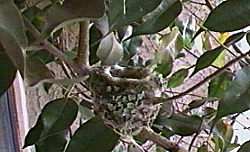
The mother hummingbird
binds plants together with spider webs
to make a tiny nest
nearly as big as a golf ball.
She sticks bits of leaves and other material
around it for camouflage.
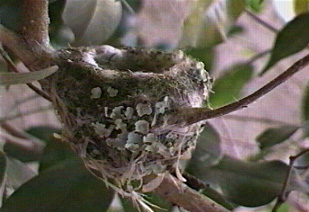
The male hummingbird helps
with neither the nest
nor the baby hummingbirds.
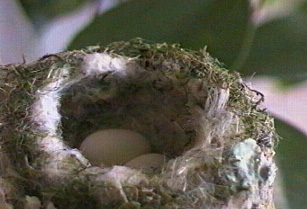
The mother hummingbird
usually lays two eggs
about the size of small jellybeans.
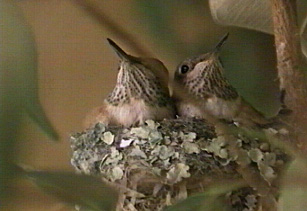
Hummingbirds live in the wild
from three to five years.
Hummingbirds are so active
they must eat an inordinate amount of food.
If a restless hummingbird
does not eat at least
every 30 minutes,
it could actually starve to death.
Small insects make up part of their diet,
especially when there are babies.
Their main food source
is nectar from flowers and trees.
Water makes up approximately
75 per cent of the nectar
and sucrose, or common table sugar,
makes up the remaining 25 per cent.

The hummingbird needs to eat
two and one half times
its body weight
in nectar every day.
This is the same as eating
about one half of
its body weight in sugar
and two times
its body weight in water.
The hummingbird must feed
from hundreds of flowers
every day in order
to get enough nectar.
Insects do not see the color red,
so they often pass
right by the red flowers,
inadvertently leaving them
for the hummingbirds.
Hummingbirds sense a red flower
might mean a fresh store
of food for them,
so they will check out
anything red ~
even lipstick or clothing.
If there is not ample food at hand
and during the nighttime,
they can go into a kind of hibernation.
If humans moved
as much as hummingbirds,
a 75 pound child
would have to eat
163 pounds of potatoes a day.
If soft drinks were as rich
in sugar as the nectar,
that child would have to drink
250 12 ounce cans of soft drink
every single day.
The famous bird artist
John Audubon
called the hummingbird
~ glittering fragments of the rainbow ~
because the hummingbird
has such beautiful, bright
and brilliant colors.
Most birds have chemical colors,
or pigments that always
show the same color ~
like the blue jay
that is always blue
no matter how the light
may hit its feathers.
While the hummingbirds do have
feathers colored with pigments,
they get their brightest colors
in a eminently different way.
Tiny layers of feather cells
break the light into brilliant colors,
just as water breaks light
to create a rainbow.
Unless the light hits
the hummingbird just right,
you won�t see any color at all
since the hummingbird
will merely look dark.
The ability to display colors
when they want to do so
is a great help to hummingbirds.
A male hummingbird
flashes his bright colors
to attract a female hummingbird
or to scare off an enemy.
Even the clever hawk
can be scared off
by a sudden burst of brilliant color.
Five to ten per cent of hummingbirds
are adult male hummingbirds
while the rest are female hummingbirds
or young hummingbirds.
The males are usually bright colored,
but although the female is not
as brightly colored as the male,
she can flash the white tips
of her tail feathers
to scare away enemies.
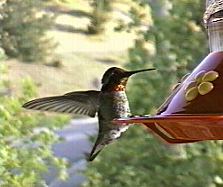
Hummingbirds are found only
on the American continents
and the Caribbean Islands.
The areas near the equator
possess the most species.
Mexico has 40 species
of the hummingbird.
Ecuador has 160 species
of the hummingbird,
the most of any country.
Sixteen species nest
in the United States
and are found in every state
except Hawaii.
The ruby-throated hummingbird
is the only species that nests
east of the Mississippi River.
Ruby-throated hummingbirds
migrate approximately 600 miles
across the Gulf Of Mexico,
flying approximately 20 hours.
They go on an eating binge
for weeks before leaving
In order to keep from starving
on their long journey.
By the time
they reach land again,
they will have burned up
almost half their body weight.
The best place in the United States
to find hummingbirds
is in southeastern Arizona
since they flock there
from many different areas.
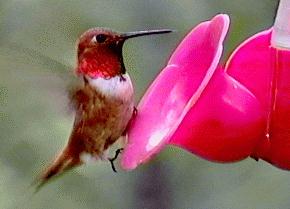
The rufous hummingbird
is the only hummingbird
known to nest in Alaska.
The rufous hummingbird
migrates 2000 miles
to Mexico each winter,
and then files back to Alaska
come the spring.
Contrary to popular belief,
hummingbirds do not hitch rides
on geese or other larger birds.

RESOURCE MATERIAL:
Terrie and Larry Gates
THE HUMMINBIRD WEB SITE
A veritable treasure
of information and opportunity
~ AND ~
H. Ross Hawkins
President
The Hummingbird Society
249 East Main Street, Suite 4
P. O. Box 394
Newark, DE 19715
USA

